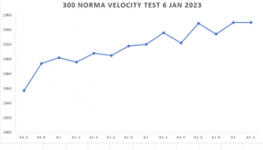Ill start by saying that I am very new to reloading and this is my first load development. I used the search function but still have a question.
I loaded up a test at 20 thousandths off the lands, started at 80.6 grains, and loaded in .2 increments up to 83.2 (14 rounds). I was very diligent about checking my magnetospeed between the first 8-10 rounds, but it never shifted and I got complacent. on shot 12, 82.8 grains, I saw a drop in velocity I wasn't exactly expecting, and checked the magnetospeed and it had shifted forward about 1/2-1 inch. I fixed it and shot rounds 13 and 14. Of course, upon reviewing the data, the graph between 82.6 and 83.2 was almost dead flat, except for that 82.8 grain shot where the chrono was loose.
My goal is to load a conservative (not in a hurry to chase max loads) and consistent load between 2850-2950.
Knowing that the magnetospeed was loose on shot 12, am I best to load up those last 4 rounds again and reshoot it, or is having the data I have about shots 10, 13 and 14, and knowing it was loose on that shot enough to invalidate it and peruse that as a node? And finally, is there any reason not to load up some rounds at the lower node (around 81 grains) which is in my goal velocity and seems stable, and disregard the potential upper node at 83-83.2? Any advice would be greatly appreciated!
Data from the days shooting:
My setup:
300 Norma Magnum
26" 1:9 Proof Carbon Fiber
230 rounds on the barrel
H1000
Lapua Brass
225 ELD Match
FED215M
Magnetospeed v3
I loaded up a test at 20 thousandths off the lands, started at 80.6 grains, and loaded in .2 increments up to 83.2 (14 rounds). I was very diligent about checking my magnetospeed between the first 8-10 rounds, but it never shifted and I got complacent. on shot 12, 82.8 grains, I saw a drop in velocity I wasn't exactly expecting, and checked the magnetospeed and it had shifted forward about 1/2-1 inch. I fixed it and shot rounds 13 and 14. Of course, upon reviewing the data, the graph between 82.6 and 83.2 was almost dead flat, except for that 82.8 grain shot where the chrono was loose.
My goal is to load a conservative (not in a hurry to chase max loads) and consistent load between 2850-2950.
Knowing that the magnetospeed was loose on shot 12, am I best to load up those last 4 rounds again and reshoot it, or is having the data I have about shots 10, 13 and 14, and knowing it was loose on that shot enough to invalidate it and peruse that as a node? And finally, is there any reason not to load up some rounds at the lower node (around 81 grains) which is in my goal velocity and seems stable, and disregard the potential upper node at 83-83.2? Any advice would be greatly appreciated!
Data from the days shooting:
| Velocity | CW |
| 2857 | 80.6 |
| 2894 | 80.8 |
| 2902 | 81 |
| 2896 | 81.2 |
| 2908 | 81.4 |
| 2905 | 81.6 |
| 2918 | 81.8 |
| 2920 | 82 |
| 2936 | 82.2 |
| 2922 | 82.4 |
| 2949 | 82.6 |
| 2934 | 82.8 |
| 2950 | 83 |
| 2950 | 83.2 |
My setup:
300 Norma Magnum
26" 1:9 Proof Carbon Fiber
230 rounds on the barrel
H1000
Lapua Brass
225 ELD Match
FED215M
Magnetospeed v3


